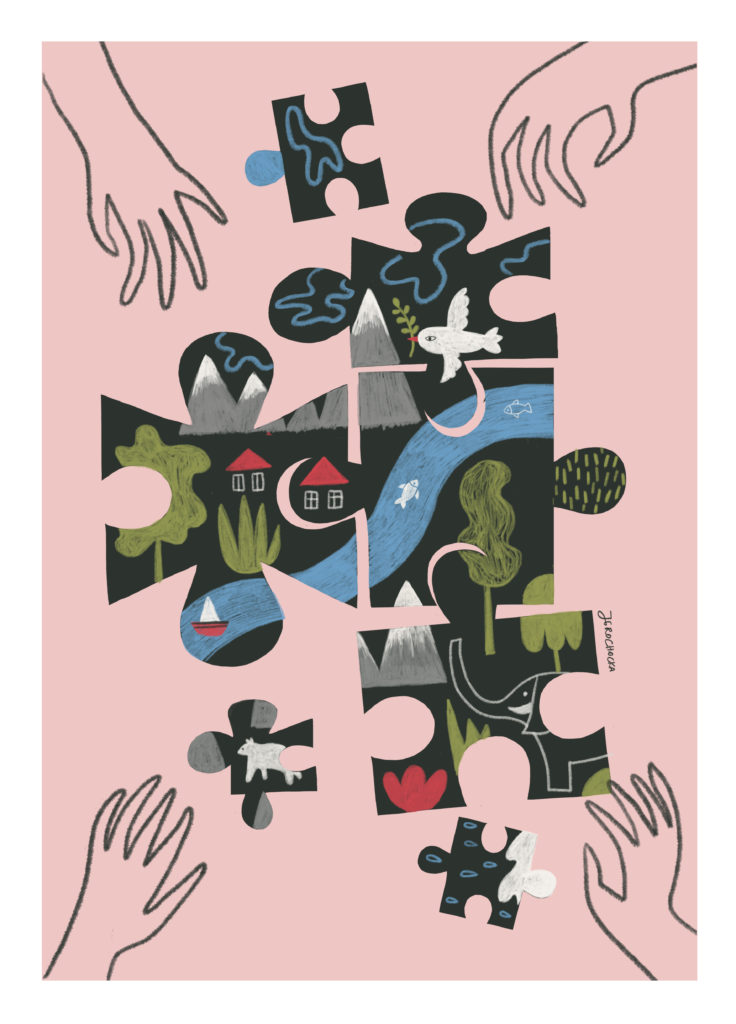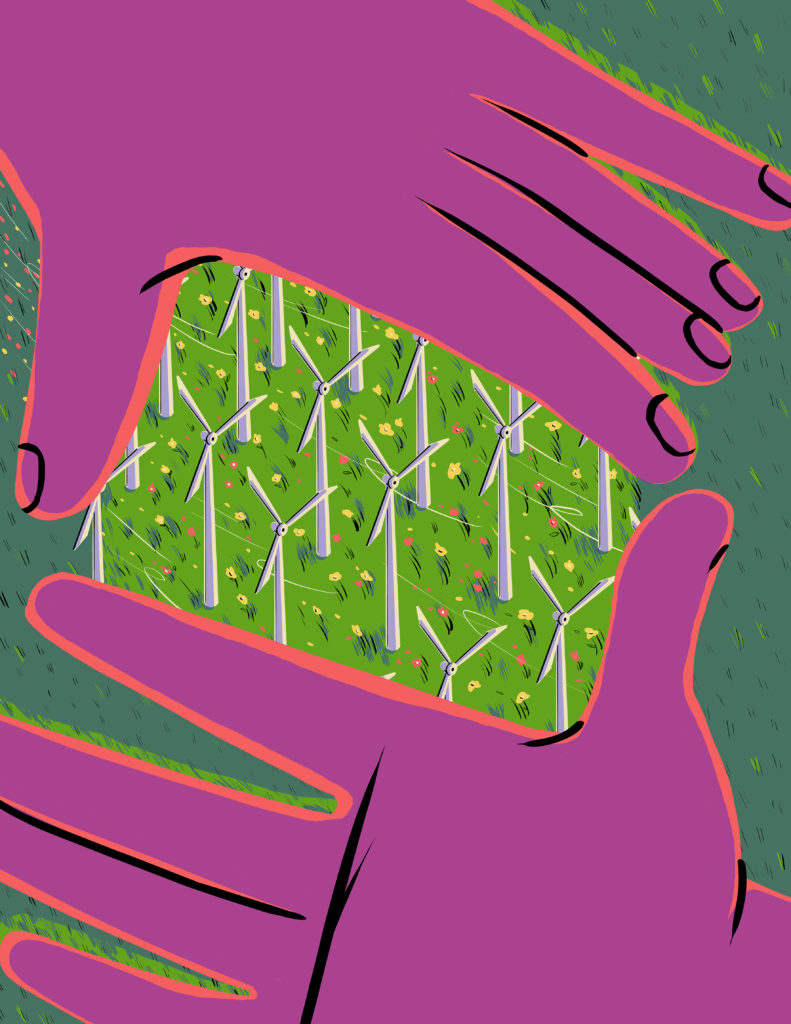The climate is in crisis. Mass extinctions and mass migrations mark our days. Cities are running out of water or deluged by it. Inequality and polarization are political cronies, their twisted outbursts manifested as information warfare. Our carbon, like our money, is always flowing out of us—up, away, into the atmosphere.
This is not the first time that things have felt hopeless. And we, as humans, have often made our greatest progress in the face of our greatest despair.
But our species has an annoying habit of procrastinating.
Technically, the solutions to our problems already exist. Since 2015, Costa Rica has generated more than 95% of its electricity from renewable energy, reaching 99% in 2017. Sweden is targeting 100% renewable energy use by 2040. As this issue went to press, IBM unveiled a new battery that runs on seawater rather than rare-earth metals, and a Canadian company celebrated the first electric seaplane voyage.
We have the technical and policy tools to implement sweeping changes to existing human systems. The problem has been that, until recently, we haven’t had the political will.
But that too is changing.
As children, we believe someone is “in charge,” tracking what’s happening in the world and what to do about it. But the last three years have taught us that there’s no one in charge.
Regardless of our age, we are the grownups. And we, the grownups, are angry at the ways in which the “adults” in the room have lied to us. We’re angry at inaction on climate change and inequality, corporate complicity with authoritarian regimes, voter disenfranchisement, police brutality, and mass shootings. Our anger has reared its head on the streets, at the ballot box, and on our screens.
While many of us are dissatisfied with the status quo, dissatisfaction alone is not enough to create the world we want.
Throughout history, great leaders have crafted visions of collective futures to inspire action. Franklin Delano Roosevelt used his 1933 inauguration address to lay out his vision for the New Deal, explaining in broad strokes how he planned to change us for the better. “When there is no vision, the people perish,” he said.
Today, we find ourselves again in need of such a vision. A successful vision enables us to coordinate across social, political, and economic spheres by creating a shared understanding of the current moment, the need for urgency, and setting big-picture goals. The most successful collective visions facilitate wide-ranging experiments to achieve their goals, while communicating a set of shared moral values to guide those experiments.
Solving problems like the climate crisis will require massive experiments across all segments of society. Regardless of our political or religious beliefs, we all have a self-interest in finding solutions, and different ideas about what those solutions are.
As part of a 2008 study, sociologist Erica Chenoweth and co-author Maria J. Stephan reviewed all known major nonviolent and violent resistance campaigns from 1900 to 2006 to determine which organizing techniques have been most successful.
Nonviolent campaigns, they found, are “more likely to win legitimacy, attract widespread domestic and international support, neutralize the opponent’s security forces, and compel loyalty shifts among erstwhile opponent supporters.”
Chenoweth’s data also showed another essential thing about political movements: No nonviolent movement has ever failed once it achieved the active, sustained participation of 3.5% of the population.
Of course, not everyone who gets behind a specific vision of the future will choose to participate in collective action. And that’s OK. There are many ways to contribute: some of us build the businesses and organizations that will help bring about change; some choose to put our money toward those organizations; some see voting and canvassing for values-aligned candidates as the path forward; some support a vision of collective liberation by refusing to cower in the face of oppression, by choosing joy. Some choose all of the above.
 YES! Illustration by Joanna Grochocka.
YES! Illustration by Joanna Grochocka.
Our connections to place, culture, common purpose, and each other create a sense of belonging that every person needs to thrive.
Here at YES!, we’ve always worked to inspire people to create a more just, sustainable, and compassionate world. Our founders believed that every person matters and deserves to lead a dignified life, and that we are part of an interconnected web of life on which our existence and well-being depend. They knew that people working together can bring that world into being, and that inspiration starts with a story of possibility. So, 24 years ago, YES! began telling stories of real people in real places coming together to solve the problems they faced, in hopes that others would be inspired to push for transformative change in themselves and their communities.
At the dawn of this decisive new decade, we at YES! feel compelled to step back, take stock, and identify the core values and guiding principles of systems change that, if widely adopted, could turn the tide. That’s why our first issue of 2020 is “The World We Want.” With it, we aim to plant the seeds for a collective 10-year blueprint to inspire and guide us all as we set out on the complicated path of building a new future, together.
To build that collective vision of a better world, we find it necessary to name what we see as the root causes of society’s problems. At the risk of oversimplification, root causes regularly appearing in YES! stories include extractive capitalism and consumerism; the troika of colonialism, racism, and patriarchy; dominion over nature and each other (militarism, at its most extreme); and social disconnection. Often, these systems intersect in ways that amplify harm to communities. The result has been to concentrate wealth and power for a few at the expense of everyone else, and the planet we depend on for survival.
Ultimately, the goal is to dismantle these destructive systems and replace them with restorative, generative systems that create lasting well-being for all people and the planet. By naming the underlying values and operating principles of those new systems, we hope to empower readers with an important tool to advance lasting change.
The principles outlined here are a work in progress, but as YES! expands its base of readers, contributors, staff, and partnerships, it’s important to be explicit, transparent, and direct. We understand much more could be said about these concepts, and we sincerely invite your feedback as we continue to delve into these guiding principles.
Well-being
When we put the well-being of people and communities first, over and above profit, we create a more peaceful world. Well-being requires material sufficiency to ensure a sense of security, health, and the pleasure of those material things that truly delight us. But the majority of our well-being comes from non-material things, including our capacity for wonder, curiosity, love, and appreciation. As a society, we can strive for abundant well-being for all, while, at a minimum, ensuring that everyone has what’s needed for survival. To get there, we must identify, measure, and improve key indicators of well-being at every level of decision-making.
Community self-determination
Much of the global despair and destruction can be attributed to decisions by a handful of people that affect billions of others. A decision by a manager at a multinational corporation on a random Tuesday can affect the prospects of thousands of communities for decades. We must flip the model to ensure a higher level of community self-determination, because people and places thrive when democratic communities determine their own social, cultural, and economic needs and solutions. We need solutions that shift economic and political control from global corporations and national bodies to communities. At the local level, we need democratic decision-making processes to ensure bottom-up, community-led solutions that maximize community benefit over private gain. To build local wealth, we’d emphasize local and community ownership of resources and enterprises, with local businesses focused on meeting local needs first, before exporting excess.
Equity
We believe that every human should have access to the opportunities and resources needed to reach their fullest potential. To do so, we must actively correct for the devastating level of past and present injustice and inequity. This means adopting solutions, policies, and approaches that shift power from the few to the many, and supporting leadership by historically marginalized communities, with those who’ve traditionally held power stepping back into supporting roles. It also means
embracing the “curb cut effect.” Rather than design solutions to meet the needs of the majority (e.g. people who cross the street with two working legs), design them to meet the needs of those with the least access (e.g. people using wheelchairs), thereby meeting the needs of everyone. To ensure economic equity, we can adopt solutions that democratize sources of wealth, rather than simply redistribute wealth. Lasting equity doesn’t mean ensuring everyone has the same amount of butter, but making sure everyone has their own cow.
Stewardship
From the air we breathe, water we drink, food we gather and grow, to the climate that supports life as we know it, our human existence and well-being depend on a thriving natural world. It’s our responsibility to care for it for ourselves and for generations beyond. Embracing opportunities that help us recognize and cultivate our connection to all living things can generate that deep sense of collective responsibility. With this understanding, we can prioritize material sufficiency over excessive consumption, and adopt solutions that foster sustainable use and restoration of our natural resources. Indigenous knowledge and practices can guide us.
Connection
What do the rise of depression, loneliness, polarization, and mass shootings have in common? Social disconnection. Our connections to place, culture, common purpose, and each other create a sense of belonging that every person needs to thrive. Historically, our day-to-day work, play, and commerce required us to connect with many different people on a personal level. With the rise of automation and the Internet, we’ve lost vital opportunities for human connection. We can rebuild our sense of connection and belonging by intentionally designing spaces and approaches to value personal relationships over anonymous transactions; foster a sense of common purpose; cultivate compassion, empathy, and appreciation; and retain, restore, and develop cultures and traditions.
Inclusion
When everyone is invited to identify problems and participate in solutions—especially those people most impacted—we can create positive, enduring change. Inclusion can slow a process, but the results are better and last longer. Fostering inclusion means inviting everyone to the party, and cultivating meaningful contributions from new, unlikely allies. It means embracing difference, illuminating intersections, and generously sharing knowledge and ideas. Developing lasting solutions that work for all requires us to collaborate and cooperate more than compete.
Resilience
Things change. And when they do, communities built on rigid ideas, infrastructure, and hierarchies struggle and fail. Adaptive communities—those designed to expect change—can create lasting peace and prosperity. Building resilience means cultivating diversity at every level, and adopting an attitude of continuous learning, creativity, and innovation. It means finding holistic solutions that fix the system (not just the symptoms) and solve multiple problems at once. Resilient communities utilize natural resources, assets, and skills unique to their place. The best part? Solutions designed for resilience can often be adapted for other communities, especially those that share similar conditions.
Integrity
Trust can take a lifetime to build and a minute to destroy. And yet, deep trust within and between communities is the foundation of lasting peace and shared prosperity for all. Ultimately, trust requires a society-wide culture and practice of integrity, especially among those in positions of influence. We build and practice integrity through moral intention backed with action—walking our talk. High-integrity communities champion transparent, inclusive decision-making. When they screw up, they acknowledge the harm caused, actively working to repair and reduce it. They have structures ensuring accountability and measuring progress toward goals. They encourage members to speak their truths, demonstrate courage, and experiment boldly. Most importantly, they don’t give up on their dreams for a better world, even when it gets hard.
Building the world we want will be one of the hardest things any of us will ever do. But guided by these principles, and working together, we can make 2020 the year that everything changed.
 YES! illustration by Kevin Whipple.
YES! illustration by Kevin Whipple.
 |
CHRISTINE HANNA is the executive director of YES! Media. She is a founder and former co-director of the Seattle Good Business Network.
|
 |
BERIT ANDERSON began her journalism career as a YES! intern and now sits on the YES! board of directors. She is the CEO and co-founder of the media company Scout Holdings, a member of the Global Shapers Community, and the director of programs for the Strategic News Service and their Future in Review (FiRe) events.
|